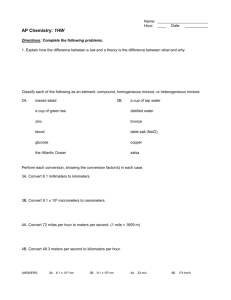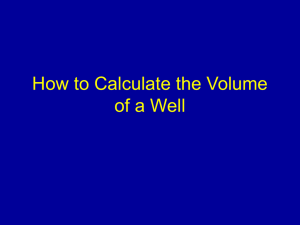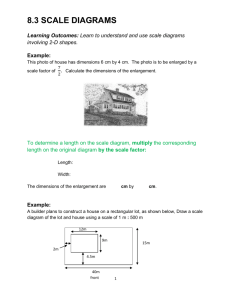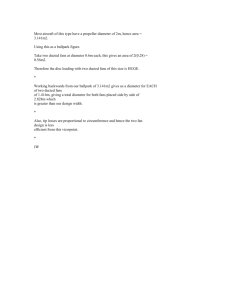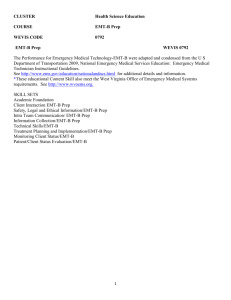How much carbon is in a tree
advertisement
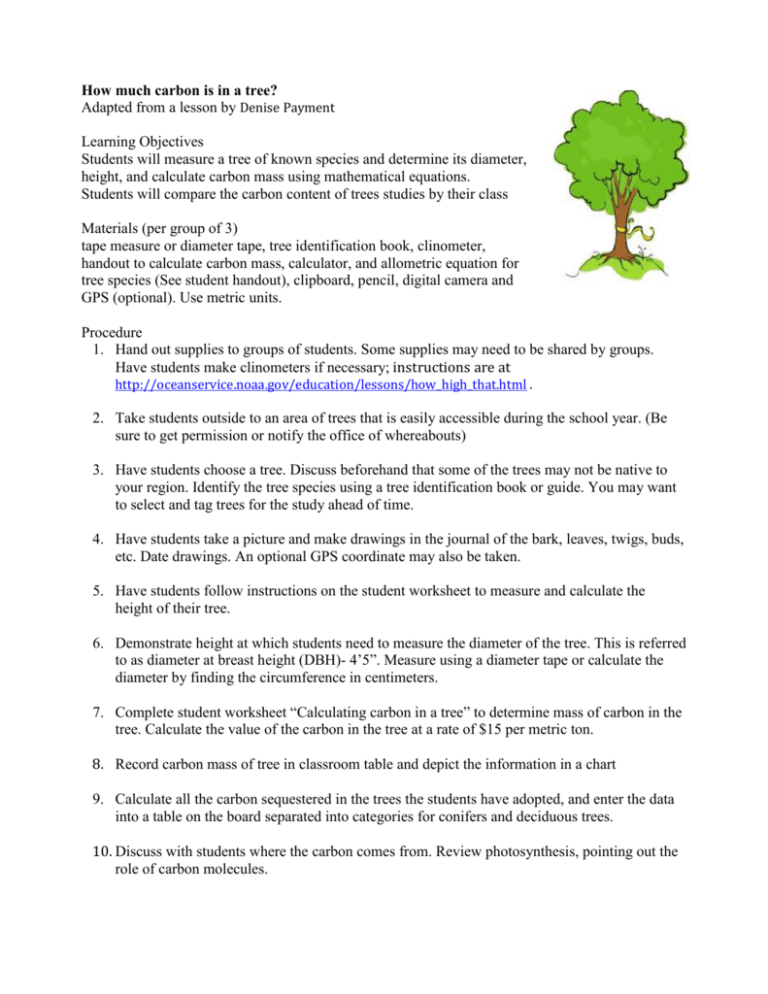
How much carbon is in a tree? Adapted from a lesson by Denise Payment Learning Objectives Students will measure a tree of known species and determine its diameter, height, and calculate carbon mass using mathematical equations. Students will compare the carbon content of trees studies by their class Materials (per group of 3) tape measure or diameter tape, tree identification book, clinometer, handout to calculate carbon mass, calculator, and allometric equation for tree species (See student handout), clipboard, pencil, digital camera and GPS (optional). Use metric units. Procedure 1. Hand out supplies to groups of students. Some supplies may need to be shared by groups. Have students make clinometers if necessary; instructions are at http://oceanservice.noaa.gov/education/lessons/how_high_that.html . 2. Take students outside to an area of trees that is easily accessible during the school year. (Be sure to get permission or notify the office of whereabouts) 3. Have students choose a tree. Discuss beforehand that some of the trees may not be native to your region. Identify the tree species using a tree identification book or guide. You may want to select and tag trees for the study ahead of time. 4. Have students take a picture and make drawings in the journal of the bark, leaves, twigs, buds, etc. Date drawings. An optional GPS coordinate may also be taken. 5. Have students follow instructions on the student worksheet to measure and calculate the height of their tree. 6. Demonstrate height at which students need to measure the diameter of the tree. This is referred to as diameter at breast height (DBH)- 4’5”. Measure using a diameter tape or calculate the diameter by finding the circumference in centimeters. 7. Complete student worksheet “Calculating carbon in a tree” to determine mass of carbon in the tree. Calculate the value of the carbon in the tree at a rate of $15 per metric ton. 8. Record carbon mass of tree in classroom table and depict the information in a chart 9. Calculate all the carbon sequestered in the trees the students have adopted, and enter the data into a table on the board separated into categories for conifers and deciduous trees. 10. Discuss with students where the carbon comes from. Review photosynthesis, pointing out the role of carbon molecules. Student Worksheet to determine the height of a tree Measure the distance from the base of the tree on a meter tape out to where you can see the top of the tree (b): _________________ m Use a clinometer or protractor to measure the angle from the horizontal to the top of the tree (A):__________ degrees Measure the distance from the ground up to observer’s eyes (z):_________ m Use the tangent of angle "A" to calculate the height of the tree H = ((tanA x b) + z H = ________________m Student worksheet for calculating carbon in a tree 1.) Measure the circumference at breast height (in cm): __________________ 2.) Calculate the diameter at breast height (in cm): ___________________ (Remember: Diameter = circumference/pi) 3.) Identify the species: ____________________ 4.) Calculate the biomass of your tree or shrub (in kg): ____________________ The formula for this is M=aDb The values for a and b for many species are given in the table following the worksheet M= biomass a= species coefficient a (See Table 1 on page 2.) D= diameter at breast height b= species coefficient b (See Table 1 on page 2.) Is this species hardwood or softwood? (The resources you used to help identify your tree species should tell you if it hardwood or softwood.) ______________________ 5.) Calculate the amount of carbon in your tree or shrub (in kg): __________________ To do this: Multiply biomass (M) by 0.521 for hardwood trees. Multiply biomass (M) by 0.498 for softwood trees. 6.) You may wish to convert kg to tons to make comparisons between your measurement and the measurement of greenhouse gases in the air: ______________ (1 metric ton = 1000 kg) Example: Diameter of a beech tree is measured at 75 cm Values for beech are a= .0842 b= 2.5715 Formula is M = aDb M = .0842 (75 ^ 2.5715) M = 5585.12 kg Beech is a hardwood, so multiply by 0.521 = Divide by 1000 kg per ton 2909.8 kg carbon in the tree = 2.91 metric tons of carbon At $15 per ton, the carbon in the tree would be worth $43.65 TABLE 1 Species-Dependent Coefficient and Exponent Values for Biomass Equation Tree Species a b Ash, white .1063 2.4798 Basswood .0617 2.5328 Beech .0842 2.5715 Birch, black/sweet .0629 2.6606 Cedar, Red .1019 2.3000 Cherry, Black .0716 2.6174 Cherry, Sweet .1556 2.1948 Elm, American .0629 2.6606 Elm, slippery/red .0629 2.6606 Black Locust .0792 2.6349 Flowering dogwood .0792 2.6349 Hackberry .0792 2.6349 Hemlock .0622 2.4500 Hickory, mockernut .0792 2.6349 Hickory, pignut .0792 2.6349 Hickory, shagbark .0792 2.6349 Hop hornbeam .0792 2.6349 Hornbeam .0792 2.6349 Maple, Red .0910 2.5080 Maple, Sugar .2064 2.5300 Oak, black .0904 2.5143 Oak, chestnut .0554 2.7276 Oak, red .1130 2.4572 Oak, white .0579 2.6887 Pine, white .1617 2.1420 Sumac, Staghorn .0825 2.4680 Values taken from: The Yale University site- http://www.yale.edu/fes519b/saltonstall/biomass2.html - estimate Note: Scientists continue to research different ways of determining the a coefficient and the b exponent, so you may choose to different values based on different research.


